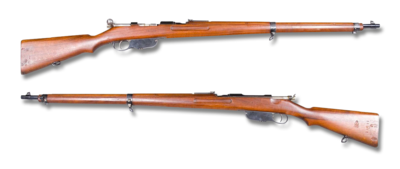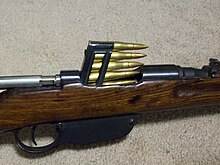Mannlicher model 1895
| Mannlicher model 1895 | |
|---|---|

|
|
| general information | |
| Military designation: | M95 carabiner |
| Developer / Manufacturer: | Steyr Mannlicher |
| Development year: | 1895 |
| Manufacturer country: | Austria-Hungary |
| Production time: | 1895 to 1918 |
| Weapon Category: | gun |
| Furnishing | |
| Overall length: | M95: 1272 mm, M95 / 30: 1000 mm |
| Weight: (unloaded) | M95: 3.8 kg; M95 / 30: 3.36 kg |
| Barrel length : | M95: 765 mm, M95 / 30: 480 mm |
| Technical specifications | |
| Caliber : | 8 × 50 mm R , 8 × 56 mm R , 7.92 × 57 mm |
| Possible magazine fillings : | 5 cartridges |
| Ammunition supply : | By loading frames of 5 shots each |
| Fire types: | Single fire |
| Closure : | Straight pull closure |
| Charging principle: | Multiple loaders |
| Lists on the subject | |
The Mannlicher Model 1895 rifle is a bolt action rifle with a straight pull bolt . It served as an orderly rifle in the Austro-Hungarian army before and during the First World War . With the Treaty of Saint-Germain , Austria was only allowed to use the short version, the model 1895 carbine. The rifle was manufactured around 5.5 million times in Austria by the Steyr Mannlicher company and in Hungary by the Budapest rifle factory. The weapon was still used in fighting until the 1970s (most recently in Africa).
Versions
The M95 was originally developed as a long infantry rifle for the Austro-Hungarian army . The rifle was mainly exported to Bulgaria (83,000 infantry rifles and 2,074 sockets between 1903 and 1914). At the beginning of World War I, there were around 850,000 M95 infantry rifles and 80,000 M95 sockets (carbines), along with 1.3 million Mannlicher rifles of older models. During the war, the army command recognized the great disadvantage of these "long" rifles in the trenches . Long rifles were increasingly converted to short socket versions and used. From 1916, the Budapest rifle factory only produced the short M95 version in the standard 8 × 50 R (M93) caliber. The total number of Mannlicher rifles produced during the First World War amounts to approximately 3,500,000, of which an estimated 25% were carbines.
After the First World War , the weapons were modernized around 1930 as part of the reorganization of the People's Army in the First Austrian Republic , which was limited to only 30,000 men on the basis of the Treaty of Saint Germain . The majority of these "long" rifles were converted into handy and quickly deployable carbines. The outdated M93 ammunition was also modernized. Previously, the relatively weak round-head ammunition had been retained because the breech of the older Mannlicher models was not strong enough for stronger cartridges. The new ammunition had a pointed head projectile and a higher propellant charge, which increased the exit speed from 545 m / s to 720 m / s. Hungary completed this conversion a year later.
Large quantities of captured M95s were sold in the interwar period, mainly by Italy and Czechoslovakia , particularly to newly formed states in Eastern Europe and countries in the Balkans. Of these, only Bulgaria had the M95 as the standard infantry rifle. In Yugoslavia , where the Mauser 98 was otherwise used as an orderly weapon, 123,000 were converted to the 7.92 × 57 caliber (called M95 / 24). The M95 continued to be produced in large numbers - in clear breach of the Treaty of Saint Germain - in both Austria and Hungary. A large part of the Austrian M95s was sold after Austria was annexed to Bulgaria. At the start of the war in 1939, however, the Wehrmacht and Waffen-SS still had 268,648 M95s.
In general, the following versions are known:
- M95 rifle caliber 8 × 50 mm R
- M95a carbine (socket) caliber 8 × 50 mm R
- Rifle and carbine M95 / 30 caliber 8 × 56 mm R (8 × 56 mm R M30 S)
- M95 / 24 carbine caliber 8 × 57 mm IS
technology
Clasp
Like its predecessor, the M1890 , the Mannlicher M1895 has a straight pull lock . In contrast to its predecessor with support flap lock, however, it is a straight pull cylinder lock in which the locking elements are attached to the front of the rotatable inner sleeve of the lock, which allows the use of stronger ammunition. With this straight pull system, as with the Swiss Schmidt-Rubin rifles at the time, a faster sequence of shots was possible than with rifles with the Mauser cylinder lock system . The straight reloading movement allowed the delivery of up to 2 rounds per second.
Due to the fast reloading movement of the bolt handle (back and forth), the M95 (rifle / carbine) was called the "quick rifle" by the soldiers in the Austro-Hungarian Army.
Cartridge feed
The cartridge is fed with the aid of loading frames of five rounds each, which are pushed into the magazine box from above when the lock is open . When empty, the loading frame falls to the floor through an opening at the bottom of the magazine. This opening means that the rifle is sensitive to dirt and the rifle can only be used as a single loader without a loading frame.
ammunition
In the 1930s, the rifles / carbines still in service were gradually converted from the old 8 × 50 R caliber from 1893 to the new 8 × 56 R cartridge. For this purpose, the chamber was rubbed to the dimensions of the 8 × 56 R cartridge. The barrel diameter for both cartridges is 8.40 mm. Since the new, lighter bullet is an ogival bullet with a torpedo tail, it could no longer be compressed in the stern area like the old round head bullet and was therefore no longer adequately guided in the trains. Therefore the bullet diameter has been increased from 8.2 mm to 8.40 mm. The bullet weight has been reduced from 15.8 g to 13.4 g. The cartridge length of 76 mm remained the same.
States of operations
Austria-Hungary, Austria, Bulgaria, Germany, Greece, Hungary, Italy, Romania, Yugoslavia, Netherlands, Ottoman Empire, Turkey, Czechoslovakia, Portugal.
Museum reception
- In the Military History Museum in Vienna a greater number of Mannlicher rifles on display, in addition, also a cutaway model and several associated bayonets .
- Salzburg Defense History Museum - SWGM , Wals-Siezenheim near Salzburg
gallery
See also
- The Mannlicher cartridge 8 × 50 R should not be confused with the cartridge 8 × 50 mm R Lebel
Web links
literature
- Hans Stögmüller: Josef Werndl and the weapons factory in Steyr , Ennsthaler-Verlag, Steyr 2010, ISBN 978-3-85068-860-4
Individual evidence
- ↑ http://www.hungariae.com/Mann95Bu.htm
- ^ Scarlata, Paul S., Mannlicher Military Rifles: Straight Pull and Turn Bolt Designs, Verlag Andrew Mowbray Inc 2004, page 32, ISBN 1-931464-14-6
- ↑ https://ww1.habsburger.net/de/medien/schwerindustrielle-produktion-und-waffenproduktion-oesterreich-ungarn-1914-1918
- ↑ Handrich, Dieter, Sturmgewehr 44: predecessor, development and manufacture of the most revolutionary infantry weapon, Verlag DWJ 2016, page 106, ISBN 3-946429-04-1
- ↑ Johann Christoph Allmayer-Beck : The Army History Museum Vienna. The museum and its representative rooms. Salzburg 1981, p. 34.







